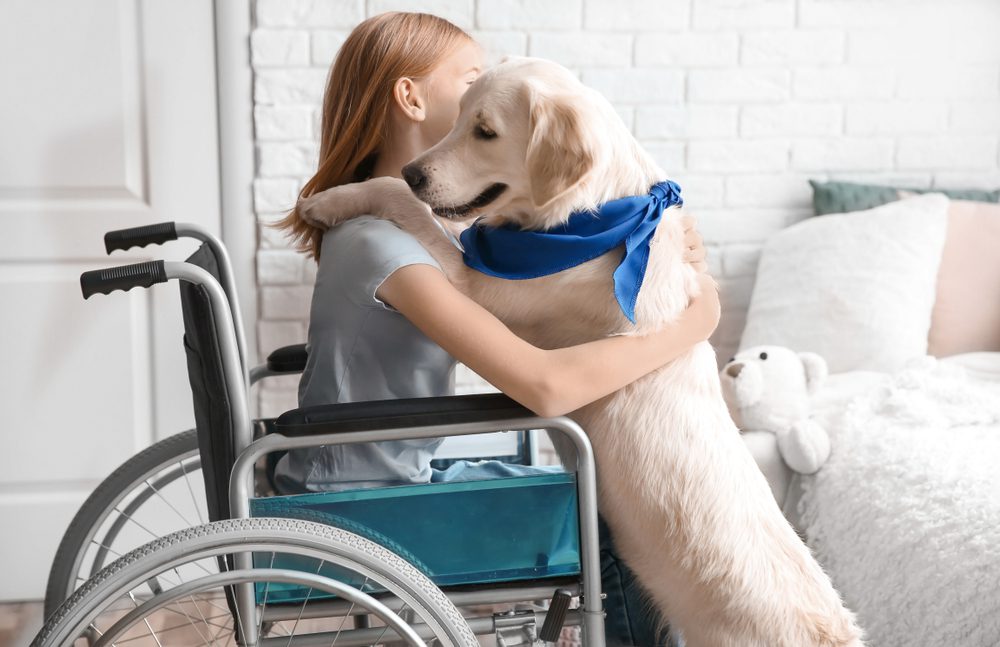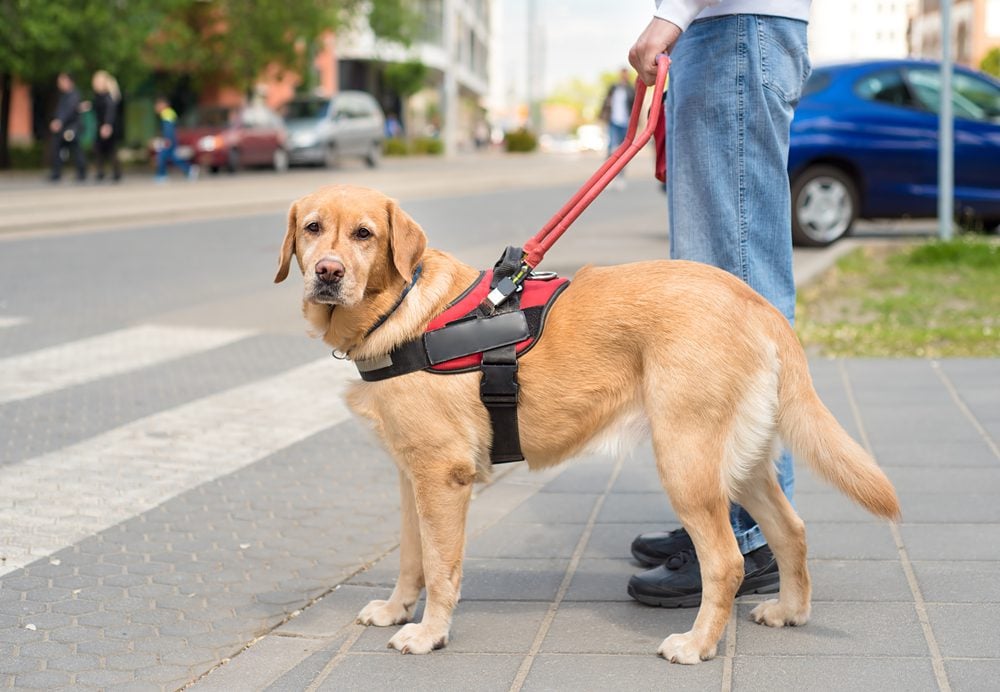Schizophrenia is a complex mental health condition that can have a significant impact on a person’s daily life. From managing symptoms to navigating everyday life, individuals with this condition often require additional support. Schizophrenia service dogs have emerged as an extraordinary source of aid for individuals grappling with this condition. Beyond their endearing companionship, these specially trained dogs offer a range of practical benefits that can significantly improve the quality of life for those with schizophrenia.
Join us as we explore the transformative impact of service dogs in the lives of individuals facing this unique challenge.
What Is a Schizophrenia Service Dog?
A schizophrenia service dog (SSD) is a type of psychiatric service dog (PSD) specifically trained to assist individuals with schizophrenia. These remarkable animals undergo extensive training to provide targeted assistance and support tailored to the unique challenges of this mental health condition. All schizophrenia service dogs undergo specialized training to develop the skills necessary to support individuals with schizophrenia. This meticulous training process requires specific qualities from the dog and the trainers.
Specialized Training Requirements
Training is the cornerstone of preparing a schizophrenia service dog for their crucial role in supporting individuals with schizophrenia. All SSDs undergo multiple types of training, including but not limited to:
- Alert Training: SSDs are trained to recognize subtle changes in their handler’s behavior that may indicate the onset of a psychotic episode.
- Task Performance: They learn a range of specific tasks to assist during episodes, such as interrupting hallucinations, providing grounding, and guiding their handler to safety.
- Obedience and Control: SSDs are trained to exhibit a high level of compliance and self-control, especially in public spaces.
- Socialization Skills: These dogs are exposed to various environments, people, and other animals to ensure they remain calm and composed in diverse settings.
Through meticulous training, schizophrenia service dogs develop the specialized skills needed to provide timely and tailored assistance during critical moments.
Necessary Temperament and Behavior
A successful schizophrenia service dog possesses specific temperament traits that are crucial for this role:
- Steady and Calm: They remain composed in various environments and situations, providing a stabilizing presence for their handler.
- Sensitivity and Empathy: They have a heightened ability to sense their handler’s emotional state and respond accordingly.
- Intelligence and Trainability: They are quick learners and can effectively execute commands and interventions.
- Non-aggressive and Non-threatening: They must be well-socialized and exhibit non-aggressive behavior towards people and other animals.
With their unique blend of empathy, intelligence, and composure, these dogs become invaluable partners for individuals managing schizophrenia.
Matching With a Handler
The process of pairing a service dog with an individual with schizophrenia is a carefully considered and pivotal step in ensuring the effectiveness of the partnership.
One needs to consider factors such as the handler’s specific needs, lifestyle, and the dog’s temperament and training. This compatibility is vital for the effectiveness of the SSD in providing the necessary support.
When there’s a seamless match, the bond between handler and dog becomes a powerful source of support and stability in the face of this challenging condition.
Tasks and Responsibilities of a Schizophrenia Service Dog
SSDs can provide a variety of tasks and services to their handlers, including:
1. Interrupting Hallucinations and Delusions
One of the most remarkable abilities of an SSD is its capacity to recognize the signs of a psychotic episode. Trained to be incredibly attuned to their handler’s behavior, they can detect changes indicating the onset of a hallucination or delusion.
When such signs emerge, the dog may employ various techniques to redirect their handler’s focus. This might include gentle pawing, licking, or even barking to gain their attention. By doing so, the SSD helps disrupt the progression of the episode, providing a critical intervention.
2. Providing Grounding and Comfort
Schizophrenia can lead to overwhelming feelings of anxiety and stress. In these moments, an SSD steps in as a steadfast source of grounding and comfort. Through physical touch and affectionate gestures, they offer a tangible sense of reassurance.
This touch provides a vital anchor for their handler, helping to bring them back to the present moment and mitigate the intensity of their emotions. The presence of the dog alone often serves as a powerful source of emotional support.
3. Guiding and Protecting
Navigating public spaces can be a daunting task for individuals with schizophrenia, particularly when faced with potential triggers. SSDs are prepared to assist their handlers in these situations. They can guide them through crowded areas, helping them stay focused and confident.
Moreover, these astute canines are adept at identifying potential sources of stress or triggers and can guide their handler away from them. In addition to guidance, SSDs provide an added layer of protection, acting as a reassuring presence that deters unwanted interactions.
4. Alerting to Medication or Treatment Times
Consistency in medication and treatment routines is crucial for individuals managing schizophrenia. SSDs can be trained to alert their handlers when it’s time to take medication or engage in specific self-care practices.
This reminder system not only ensures that important routines are followed but also empowers individuals to take an active role in their well-being.
In addition to these tasks, SSDs can also provide companionship and unconditional love to their handlers. This can be particularly important for people with schizophrenia, who may feel isolated and misunderstood.
Legal Considerations and Rights of Schizophrenia Service Dogs
All service dogs, including schizophrenia service dogs, are protected under the Americans with Disabilities Act (ADA). This act plays a pivotal role in ensuring that individuals with disabilities have the right to be accompanied by their service dogs in various public places, such as restaurants, stores, workplaces, and government buildings.
The ADA prohibits discrimination against people with disabilities in all areas of public life, including employment, education, transportation, and state and local government services.
If a business or organization refuses to allow an SSD to enter, they may be in violation of the ADA. The ADA provides for civil penalties for businesses and organizations that violate the law.
Americans with Disabilities Act (ADA) Guidelines
Under the ADA, service dogs are defined as dogs that are specifically trained to do work or perform tasks for the benefit of an individual with a disability. The functions performed by a service dog must be directly related to the individual’s disability.
Here’s a quick rundown of the key guidelines per the ADA:
- Public Access: SSD handlers have the right to bring their service dogs into most public places, including restaurants, stores, and public transportation.
- No Discrimination: Businesses and institutions must allow SSDs to accompany their handlers, and they cannot ask about the nature of the handler’s disability.
- Training Requirements: While there is no official certification for service dogs, they must be trained to perform specific tasks that directly assist with the handler’s disability.
- Control and Behavior: SSDs must be under control at all times, and they should not pose a threat or disruption to the public.
Understanding the specifics of the ADA can help SSD handlers assert their rights and educate others about the importance of their service dog.
Public Access Rights for Schizophrenia Service Dogs
While the ADA provides essential protections, it’s important to recognize that SSD handlers also have responsibilities, particularly regarding their dog’s behavior in public areas. Some key points to consider include:
- Basic Etiquette: SSDs should be well-behaved, non-aggressive, and respond promptly to their handler’s commands.
- Cleanliness and Grooming: Handlers should ensure that their SSD is clean, well-groomed, and not carrying an unpleasant odor.
- Restroom Breaks: Handlers are responsible for ensuring that their SSD has regular opportunities for restroom breaks.
- Training Maintenance: Ongoing training and reinforcement of SSD skills are crucial to maintain their effectiveness.
By adhering to proper etiquette and behavior guidelines, SSD handlers contribute to the positive representation of service dogs and reinforce the rights of individuals with disabilities. If you have any questions about the legal considerations or rights of SSDs, it is in your best interest to consult with an attorney who specializes in disability law.



Choosing, Acquiring, and Training a Schizophrenia Service Dog
When choosing and acquiring a schizophrenia service dog, there are a few things you should keep in mind:
Define the Tasks
To ensure your schizophrenia service dog, start by listing the specific tasks you would like your canine companion to be able to perform. This list serves as a valuable guide in selecting a dog with the right temperament and capabilities. It helps narrow down your choices, ensuring that the SSD is equipped to provide the necessary support during critical moments.
Choose the Right Breed
When it comes to servicing schizophrenia patients, certain breeds have demonstrated exceptional aptitude in assisting individuals with mental health conditions. Popular breeds for SSDs include Retrievers, German Shepherds, and Poodles. These breeds are known for their intelligence, trainability, and empathetic nature – qualities essential for effective service work.
Acquiring a Schizophrenia Service Dog
You can purchase a trained service dog from a reputable service dog organization, or you can train a dog yourself.
If you are considering purchasing a trained SSD, be sure to research the organization carefully. Make sure that the organization has a good reputation and that they use humane training methods.
Alternatively, if you are considering training a dog yourself, be sure to do your research. There are many resources available to help you train an SSD. However, it is important to note that training an SSD is a significant commitment of time and energy.
Training a Schizophrenia Service Dog
Training a schizophrenia service dog is a comprehensive process that requires dedication, consistency, and a deep understanding of the specific needs of individuals with schizophrenia. Here’s a quick overview of the key steps involved in training an SSD:
- Foundation Training: This phase covers basic obedience commands, socialization, and behavioral training.
- Task-Specific Training: This involves teaching the SSD to recognize signs of distress, and intervene during episodes.
- Public Access Training: This includes specialized training to maintain focus in public, cope with various stimuli, and adhere to legal and behavioral standards.
Regardless of the breed you choose or the training methodology you implement, the ultimate goal is to establish a strong and effective partnership between you and your service dog, ensuring they can provide the essential support you require.
Supporting Schizophrenia: Canine Companions at Your Side
Schizophrenia service dogs provide crucial support for individuals managing schizophrenia. Through specialized training, they assist during episodes, offer comfort, and guide in public spaces.
Protected by the Americans with Disabilities Act, SSDs play a vital role in enhancing the quality of life for those with schizophrenia. Choosing, acquiring, and training an SSD is a significant commitment, ultimately leading to a powerful partnership.
